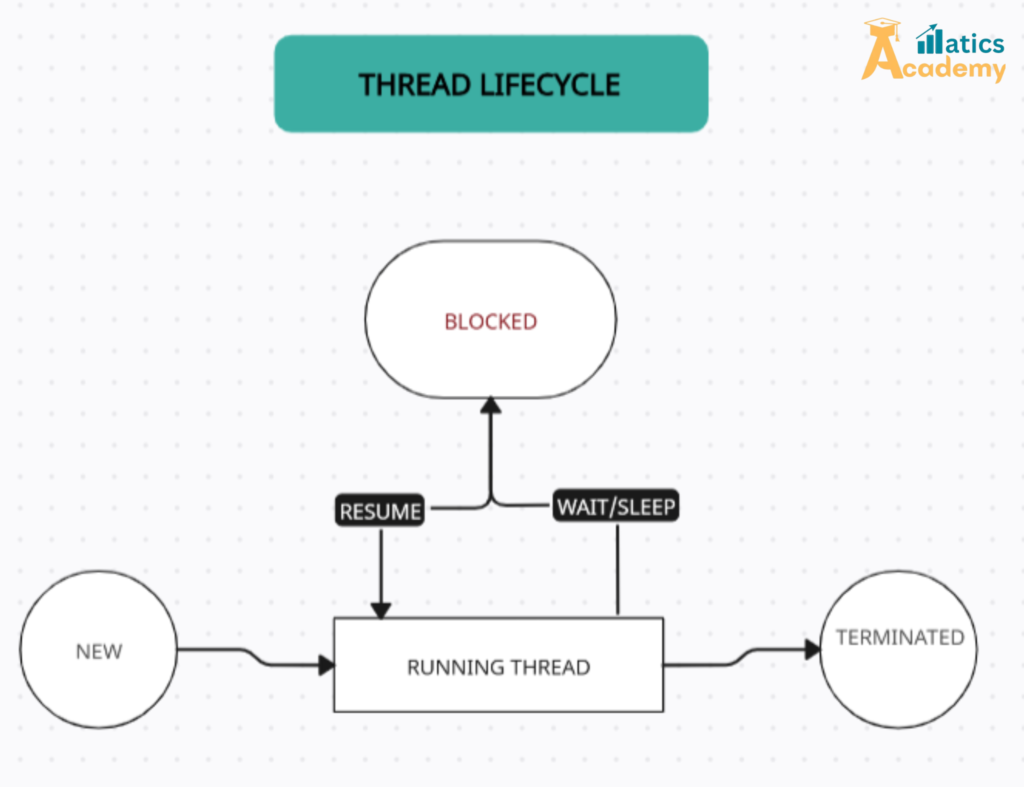Thread lifecycle are a advance and powerful feature in Python that allow you to run tasks concurrently, improving efficiency in programs. Using the advance python thread or threading module, you can create and manage multiple threads to perform various tasks at the same time.

What is a Thread?
A advance python thread is a lightweight sub-process that shares the same memory space as the main program. This enables faster communication between threads but requires careful synchronization to prevent data corruption. Threads are especially useful for tasks that involve waiting, such as reading from files or making network requests.
How to Create a python Thread
To create a thread, you need to define a target function that the thread will execute. This function can perform any task you need, and you can pass parameters to it using the args parameter.
Steps to Create a advance python Thread
- Import the
threadingmodule. - Define the function that will be executed by the thread.
- Create the thread by passing the target function to the
Threadclass. - Optionally, pass any arguments to the function using
args.
Example:
# Define the function for the thread
def print_numbers():
for i in range(1, 6):
print(i)
# Create the thread
number_thread = threading.Thread(target=print_numbers)
# Start the thread
number_thread.start()
In this example, the print_numbers() function will execute in a separate thread. The main program can continue running concurrently without waiting for the thread to finish.
Mini Project: Thread Lifecycle in Python
This project will create a few threads that simulate some tasks (e.g., printing messages) and will demonstrate the lifecycle states: New, Runnable, Terminated.
Code
import time
import threading # Import the threading module
# Task that a thread will perform
def task(thread_name):
print(f"Thread {thread_name}: Starting task.")
time.sleep(2) # Simulate some work with a 2-second sleep
print(f"Thread {thread_name}: Task completed.")
# Create threads and demonstrate thread lifecycle
def main():
# Thread 1 - Creating thread
thread1 = threading.Thread(target=task, args=("T1",))
thread2 = threading.Thread(target=task, args=("T2",))
# Print state of the threads (New state)
print(f"Thread 1 State: {thread1.is_alive()}")
print(f"Thread 2 State: {thread2.is_alive()}")
# Start threads (Runnable state)
print("Starting threads.")
thread1.start()
thread2.start()
# Print state after starting
time.sleep(1) # Give time for threads to start running
print(f"Thread 1 State: {thread1.is_alive()}")
print(f"Thread 2 State: {thread2.is_alive()}")
# Wait for threads to finish (Terminated state)
thread1.join()
thread2.join()
# Print state after completion
print("Both threads have finished execution.")
print(f"Thread 1 State: {thread1.is_alive()}")
print(f"Thread 2 State: {thread2.is_alive()}")
if __name__ == "__main__":
main()
Explanation of the Code:
1.Importing Modules:
threading: For creating and managing threads.time: To simulate time delays (like thesleepfunction) for thread execution.
2.task Function:
- This function is what each thread will execute. It takes a
thread_nameargument and simulates a task by sleeping for 2 seconds.
3.Creating Threads:
threading.Thread(target=task, args=("T1",)): This creates a new thread, wheretargetis the function to be executed, andargscontains the arguments passed to that function (in this case,"T1"or"T2").
4.Thread States:
is_alive(): This method is used to check if the thread is still alive. Before starting, it will printFalse, showing the thread is in aNewstate. After starting, the thread will be in aRunnablestate. Once completed, it will be in aTerminatedstate.
5. Starting and Joining Threads:
start(): This method begins the thread’s activity.join(): This makes the main program wait until the thread completes its task before moving on.
Lifecycle Example:
- Initially, the threads are in the
Newstate. - After calling
start(), the threads move to theRunnablestate and start executing. - Once the threads complete their tasks (after the
join()method), they enter theTerminatedstate.
Python Thread State Lifecycle Explanation:
- New: The thread has been created but hasn’t started yet.
- Runnable: The thread is running or ready to run.
- Terminated: The thread has completed its execution.
Why Use Python Threads States?
- Concurrent Execution: Threads allow multiple tasks to be performed simultaneously, improving performance.
- Resource Efficiency: Threads share the same memory space, so they are lighter on resources compared to processes.
- Improved Responsiveness: By using threads, a program remains responsive even during long-running operations.
Creating threads is an essential skill when you need to execute multiple tasks in parallel, such as handling multiple user requests in a web server.
Conclusion: Understanding the Advanced Thread Lifecycle in Python for Enhanced Performance
Mastering the thread lifecycle in Python is crucial for optimizing multithreaded applications. By understanding the different states—New, Runnable, and Terminated—developers can efficiently manage threads, ensuring optimal resource utilization and improved application performance. Python’s threading module provides an essential toolset for concurrent execution, enabling developers to create responsive, high-performing programs, especially in resource-heavy tasks.
Interview Questions for “TechSoft Solutions”
1.Why should you use advance python thread?
Answer: Threads allow concurrent execution, which improves the performance of I/O-bound tasks without blocking the main program.
2. How do you pass arguments to a thread’s function?
Answer: You pass arguments using the args parameter in the Thread() constructor.
3.What happens when you create a thread but don’t start it?
Answer: The thread will be created but won’t execute until you call its start() method.
4. How can you identify a thread’s function in Python?
Answer: You define a function and pass it to the Thread class using the target parameter.
5. Can you create multiple threads in Python?
Answer: Yes, you can create multiple threads to execute different tasks concurrently.
Thread Life Cycle
Question
Your answer:
Correct answer:
Your Answers
